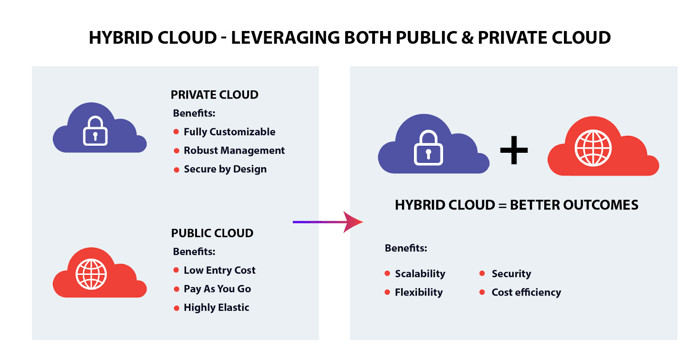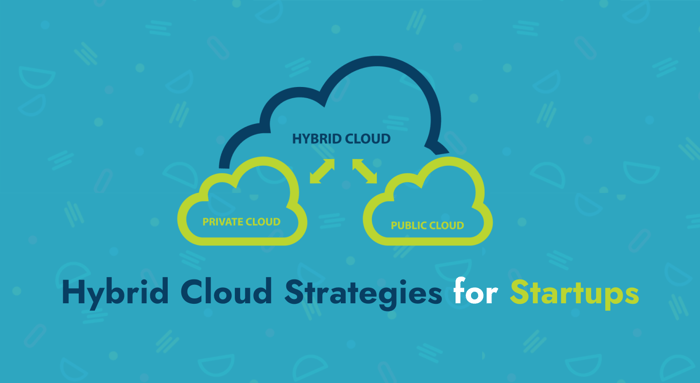Table of Contents
Explore how startups can leverage hybrid cloud solutions to scale efficiently.
As startups strive to remain agile and competitive, they need a cloud strategy that balances flexibility, scalability, and cost-efficiency. This is where the hybrid cloud model comes into play. By combining the advantages of both private and public cloud environments, hybrid cloud offers a flexible infrastructure that adapts to the needs of growing businesses without overextending resources.
Startups benefit from hybrid cloud because it allows them to optimize their IT costs by leveraging the cost-saving potential of the public cloud for non-sensitive workloads while maintaining control and security for mission-critical applications on private cloud infrastructure. This balance ensures that startups can scale operations as needed, without sacrificing performance or security.
One key feature of hybrid cloud is its ability to facilitate disaster recovery and business continuity, enabling rapid recovery of data stored in the public cloud during emergencies. Additionally, hybrid cloud supports "cloudbursting," where startups can tap into public cloud resources during periods of high demand, allowing them to manage traffic spikes without the need for expensive, underutilized infrastructure.
According to IBM, 77% of companies worldwide have adopted a hybrid cloud approach, highlighting its growing importance in modern IT strategy. For startups looking to scale quickly, remain cost-conscious, and ensure security, hybrid cloud presents an ideal solution. This approach not only provides the necessary flexibility for unpredictable growth but also allows businesses to future-proof their infrastructure by keeping pace with the latest advancements in cloud technology.
In this article, we will explore key hybrid cloud strategies that startups can adopt to balance performance, security, and cost-effectiveness, ensuring they build a robust and adaptable IT framework for the future.
What is a Hybrid Cloud Strategy?

Firstly, what is Hybrid Cloud?
Hybrid cloud is a computing environment that integrates both public and private cloud infrastructures through broadband or a wide area network (WAN). This approach enables organizations to harness the scalability, flexibility, and cost-efficiency of public clouds while retaining oversight of sensitive data and essential applications on a private cloud or on-premises infrastructure.
Public Cloud: In a public cloud environment, third-party providers such as Amazon Web Services (AWS), Google Cloud Platform (GCP), and Microsoft Azure deliver computing resources, including servers, storage, and networking, to customers via the Internet. The public cloud is characterized by its high scalability, providing on-demand resources without requiring businesses to make upfront investments in physical infrastructure.
Private Cloud: In contrast, a private cloud entails a dedicated infrastructure that is either hosted on-premises or by a third-party provider. The organization retains complete control over the environment, including management and access. This high level of control enables enhanced security and customization, rendering it suitable for sensitive data or mission-critical applications, albeit at a higher cost compared to public cloud solutions.
Hybrid cloud architecture facilitates the seamless movement of applications, workloads, and data across various environments, empowering businesses to tailor their IT operations to their precise requirements. This approach allows the utilization of public cloud resources for less-sensitive tasks, while relying on private cloud or on-premises systems for the management of critical data, thus combining the advantages of both environments.
What is a Hybrid Cloud Strategy in a Startup Environment?
A hybrid cloud strategy for startups is all about striking the right balance between agility and control. Startups often face resource constraints and need to scale their operations rapidly while being mindful of budget and security requirements. Here’s how a hybrid cloud strategy fits into that:
Scalability and Flexibility: Startups typically start with minimal infrastructure but may experience rapid growth. Using a public cloud allows them to scale resources on demand without significant upfront investments in hardware. When they need more control or security, they can incorporate a private cloud or on-premises setup for specific workloads, such as handling customer data or sensitive business logic.
Cost-Effectiveness: A hybrid cloud strategy enables startups to use the public cloud for non-critical workloads to minimize costs, as they only pay for what they use. At the same time, they can maintain private cloud environments for critical functions that require more stringent controls or compliance measures.
Seamless Digital Transformation: Many startups today rely on innovative technologies like AI, machine learning, and data analytics to drive their business. A hybrid cloud strategy allows easy access to these public cloud services, while still integrating them with their existing private cloud or on-premises systems.
Agility in Experimentation: A startup can use the hybrid cloud to rapidly develop and test new features or applications in the public cloud. If these features require more stringent security or operational control after scaling, they can be moved to the private cloud. This approach allows startups to innovate quickly without risking security or incurring large costs upfront.
Enhanced Security and Compliance: While startups may not have the resources of larger organizations, they still need to ensure data privacy and meet industry-specific compliance standards. With a hybrid cloud approach, they can store sensitive data in a private cloud, which offers greater control over security measures, while using public cloud services for less sensitive operations.
In a startup setting, a hybrid cloud approach optimizes efficiency by capitalizing on the cost-effectiveness of the public cloud for tasks that require scalability, while also making use of private cloud infrastructures for the management of critical data, security, and compliance. This approach provides startups with the flexibility needed for rapid growth, without sacrificing control and security.
Key Considerations For Assessing Your Startup’s Needs
When assessing your startup's needs, especially regarding cloud infrastructure, it’s crucial to adopt a strategic approach that aligns with both current objectives and future growth. Below are key considerations for startups as they evaluate their business needs and build a hybrid cloud strategy:
1. Evaluate Business Goals and Cloud Readiness
Identify Core Needs: Startups should begin by defining clear business objectives. Ask questions such as: Which data or applications require the most control or enhanced security? What workloads can remain in public cloud environments? This helps differentiate between on-premises infrastructure needs and cloud-compatible workloads.
Plan for Growth: As your business expands, anticipate infrastructure demands. Ensure your cloud solution can scale to accommodate growth in user base, data, or application complexity.
2. Assess Infrastructure and Workloads
Current State of Infrastructure: Evaluate your existing hardware, storage, and network setups. Identify which systems need upgrades or replacements and which can be migrated to a cloud environment. Some workloads may benefit from refactoring to leverage cloud-native capabilities, while others might use a lift-and-shift approach.
Data Privacy and Compliance: Consider regulatory and data protection requirements when designing your hybrid cloud. For instance, workloads with sensitive data might remain in a private cloud to ensure tighter control and compliance.
3. Select the Right Cloud Services and Providers
Service Models: Understand the cloud service models (IaaS, PaaS, SaaS) and determine the best fit based on your business requirements. A hybrid strategy often combines these models to optimize performance and costs.
Choosing a Provider: Evaluate cloud service providers based on pricing, service level agreements (SLAs), and compliance guarantees. Ensure compatibility with your existing infrastructure and assess potential long-term partnerships for evolving needs.
4. Design a Secure Hybrid Cloud Architecture
Security First: Security is a top priority for startups, especially those handling sensitive customer data. Implement end-to-end encryption for data in transit and at rest, use strong Identity and Access Management (IAM) policies, and ensure VPNs are set up for secure communication between on-premises and cloud systems.
Compliance Considerations: Make sure your hybrid cloud architecture meets all industry regulations and standards (e.g., GDPR, HIPAA). Consider automated tools for continuous compliance monitoring to reduce risk.
5. Governance, Monitoring, and Optimization
Establish Clear Policies: Set governance policies for both resource provisioning and data management, ensuring control across both on-premises and cloud environments.
Monitor and Refine: Use monitoring tools to track performance, costs, and security. Continuously optimize your hybrid environment by adjusting resource usage and leveraging new cloud services and technologies.
By integrating these steps, startups can build a hybrid cloud strategy that balances flexibility with security and compliance, paving the way for sustained growth and innovation.
Challenges Hybrid Cloud Poses
While hybrid cloud offers flexibility and scalability, there are several challenges that organizations must navigate when implementing a hybrid cloud strategy. Below are some of the key challenges associated with hybrid cloud environments:
Multiple Cloud Integration Challenges: One of the most complex aspects of hybrid cloud is managing multiple cloud environments, often from different providers. In a typical hybrid setup, organizations may use both public and private clouds, along with on-premises infrastructure.
Cloud Cost Confusion: The hybrid cloud model often leads to hidden costs that are difficult to predict. When combining public and private cloud environments, businesses may encounter unforeseen expenses, such as software licensing fees, unused virtual machines (VMs), or data egress charges for moving data out of a public cloud. Without careful planning and cost analysis, these hidden charges can quickly escalate, making it challenging to maintain cost-efficiency.
Scalability Challenges: One of the primary reasons for adopting a hybrid cloud strategy is scalability, especially for bursting workloads into the public cloud. However, scalability can become a challenge if private cloud applications are restricted by on-premises firewalls or legacy systems that are not easily adaptable to public cloud resources.
Complexity in Tooling and Management: Hybrid cloud environments often require multiple tools, integrations, and vendors to manage both the public and private cloud infrastructures. There is no "one-size-fits-all" solution when it comes to hybrid cloud management, and businesses must carefully choose the right tools and platforms for each specific use case. This fragmentation can increase the complexity of managing the overall cloud environment, requiring expertise to maintain integrations, automate workflows, and ensure smooth operations across diverse infrastructure.
Security and Compliance: Ensuring security and compliance across hybrid cloud environments is another major challenge. With workloads spread across public, private, and on-premises infrastructures, maintaining consistent security policies can be difficult.
Legacy System Dependencies: Many businesses still rely on legacy systems, which can complicate the transition to hybrid cloud environments. Legacy systems may have dependencies that make it difficult to modernize or integrate with new cloud platforms. In some cases, the migration of these systems could lead to slowdowns, downtime, or operational disruptions.
Cultural Resistance and Skills Gaps: The adoption of a hybrid cloud strategy can create cultural friction within organizations. Some teams may be quick to embrace cloud technology, while others may resist change, particularly if there are gaps in cloud-related skills. This can lead to uneven adoption across different business units and limit the effectiveness of the hybrid cloud.
Migration Risks: Migrating workloads to a hybrid cloud environment poses several risks. Inadequate planning, skipping key integrations, or cutting corners during migration can result in broken workflows, data loss, or inefficient infrastructure. These issues can decrease productivity and increase costs.
By addressing these challenges with a strategic approach, organizations can fully harness the flexibility, scalability, and cost benefits of hybrid cloud infrastructure. However, it requires a combination of the right tools, expertise, and a clear vision to ensure a smooth hybrid cloud adoption.
Choosing the Right Hybrid Cloud Provider
When businesses and startups transition to hybrid cloud environments, selecting the right cloud provider is a critical decision. Several leading providers offer robust hybrid cloud solutions, including AWS, Microsoft Azure, and Google Cloud. However, the choice depends on multiple factors that align with both current needs and long-term strategies.
Top Hybrid Cloud Providers
Rank | Provider | Data Centers | Services |
1 | Microsoft | 64 regions | Azure Arc, Azure Stack |
2 | AWS | 33 regions | Outposts, EC2, EKS Anywhere |
3 | IBM/Red Hat | 175+ countries | Cloud Satellite, Red Hat OpenShift |
4 | VMware | 120+ countries | Cloud Foundation, vRealize |
5 | 40 regions | Anthos, Distributed Cloud, GKE | |
6 | HPE | 170+ countries | GreenLake, Synergy, SimpliVity |
7 | Dell | 180+ countries | APEX Cloud, VMware Cloud on Dell |
8 | Cisco | 115+ countries | InterCloud Fabric, CloudCenter |
9 | Oracle | 24 countries | Cloud@Customer, FastConnect |
10 | Nutanix | 160+ countries | Acropolis, Calm, Xi Leap, HCI |
Factors to Consider When Choosing a Provider
Support and Resources: A provider’s level of customer support is crucial, especially for startups with smaller IT teams. Look for vendors offering strong technical support, training resources, and an active community. Some providers, like Microsoft and Google, are known for excellent developer support, while AWS offers vast documentation but may require more self-service learning.
Pricing Models: Hybrid cloud pricing can be complex. Beyond standard cloud usage fees, consider hidden costs like data egress charges, VM underutilization, and additional software licenses. Providers like AWS and Azure offer detailed cost calculators, but understanding the true cost of migrating workloads across public and private clouds is critical. Consider starting small and scaling up to avoid unexpected costs.
Integration Capabilities: The ability to integrate a provider’s services with existing infrastructure and third-party tools is essential. Evaluate how well the provider's hybrid cloud solutions integrate with your current environment, including on-premise systems, databases, and software platforms. For example, Azure is often favored for businesses already using Microsoft products, while AWS offers more flexibility across various tech stacks.
Ease of Use: A platform’s user-friendliness can influence the speed of adoption within a startup. GCP, for instance, is known for its modern and developer-friendly interfaces, while AWS offers comprehensive but more complex services that may require in-depth knowledge to manage. Simplicity can be a key factor for startups without extensive in-house expertise.
Security and Compliance: Ensuring that the hybrid cloud provider meets regulatory requirements for data protection and privacy is vital, especially for industries such as healthcare or finance. Providers like IBM/Red Hat and Azure tend to emphasize security and compliance for hybrid environments. Additionally, look for providers with tools to monitor and manage cloud security across both public and private clouds.
Tips for Selecting a Vendor That Supports Growth
Scalability: Select a hybrid cloud provider that can scale with your startup’s growth. Look for flexible pricing models that allow you to start with minimal resources and scale as needed without incurring high upfront costs. AWS and Azure, for instance, are known for their ability to scale seamlessly, which can be vital for startups anticipating rapid growth.
Vendor Lock-In: Consider how easy it will be to move data and workloads if you decide to switch providers in the future. While cloud providers offer unique features, avoid lock-in by choosing vendors that support open standards and offer robust data portability options.
Long-Term Vision: Align your provider’s offerings with your startup’s long-term goals. For example, if you plan to integrate advanced AI/ML technologies or focus heavily on data analytics, choosing a cloud provider like Google Cloud that excels in these areas could offer competitive advantages.
Multi-Cloud Strategies
Many startups today adopt a multi-cloud strategy, which involves using more than one cloud provider to avoid vendor lock-in and optimize performance for different workloads. Hybrid cloud architecture plays a key role in maintaining flexibility across these providers. By combining public and private clouds, hybrid infrastructure allows startups to dynamically allocate workloads based on performance, cost, and security requirements.
Flexibility: Multi-cloud allows businesses to select the best cloud service for each workload. For instance, a startup might use AWS for scalable infrastructure and Google Cloud for advanced data analytics. Hybrid cloud architecture facilitates this flexibility by integrating both public and private resources, providing a consistent management layer.
Resilience: Using multiple cloud providers can enhance reliability. If one provider experiences downtime, critical workloads can be moved to another provider, ensuring uninterrupted service.
Cost Optimization: By leveraging a mix of public and private clouds, startups can optimize costs. For example, they might run less critical workloads on a low-cost public cloud while keeping sensitive data and mission-critical applications on a secure private cloud.
Choosing the right hybrid cloud provider involves balancing factors like support, pricing, integration, and scalability. For startups, it’s crucial to select a provider that aligns with long-term growth strategies and enables flexibility. Whether adopting a single provider or a multi-cloud strategy, the goal is to build an agile, cost-effective infrastructure that supports innovation and adapts to evolving business needs.
Conclusion
In conclusion, hybrid cloud solutions offer startups the scalability, cost management, and security needed to grow efficiently in today’s dynamic business environment. By adopting a hybrid approach, startups can seamlessly scale their operations, optimize IT costs, and ensure data security by balancing workloads across private and public cloud environments.
However, startups must choose hybrid cloud providers that align with their long-term business strategies and growth goals. Flexibility is key, and as the business evolves, so too should its cloud strategy. Continuous evaluation of cloud infrastructure and adapting to new technologies will enable startups to remain competitive and meet the demands of an ever-changing market. Planning with the future in mind ensures that startups can leverage hybrid cloud to fuel innovation and long-term success.
Akava would love to help your organization adapt, evolve and innovate your modernization initiatives. If you’re looking to discuss, strategize or implement any of these processes, reach out to [email protected] and reference this post.





